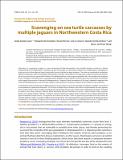| dc.contributor.author | Carrillo, Eduardo | |
| dc.date.accessioned | 2020-05-28T03:07:05Z | |
| dc.date.available | 2020-05-28T03:07:05Z | |
| dc.date.issued | 2016 | |
| dc.identifier.uri | http://hdl.handle.net/11056/17452 | |
| dc.description.abstract | Information on scavenging by jaguars is scarce, dispersed and little documented in the scientific literature, producing a shallow understanding of this phenomenon. Therefore, the aim of this paper is to describe the behavior of multiple jaguars scavenging on single carcasses of olive ridley sea turtles (Lepidochelys olivacea) that died by jaguar predation. The study was conducted at two beaches (Naranjo and Nancite) within the Santa Rosa National Park, Costa Rica. We carried out morning walks on Naranjo and Nancite beaches. We set up camera traps to capture the full extent of the feeding behavior on fresh jaguar-predated turtles. We recorded two scavenging events. The jaguars involved in the two scavenging events dragged or tried to drag the sea turtle carcass to a new location. This behavior could suggest the presence of intraspecific kleptoparasitism. However, further investigation of this type is required to determine the existence of kleptoparasitism, and also to get a deeper understanding of scavenging in jaguars and its relation to prey availability. | es_ES |
| dc.description.sponsorship | Universidad Nacional, Costa Rica | es_ES |
| dc.language.iso | eng | es_ES |
| dc.publisher | Therya | es_ES |
| dc.rights | Acceso abierto | es_ES |
| dc.title | Scavenging on sea turtle carcasses by multiple jaguars in northwestern Costa Rica | es_ES |
| dc.type | http://purl.org/coar/resource_type/c_6501 | es_ES |
| dc.description.procedence | Facultad de Tierra y Mar | es_ES |

